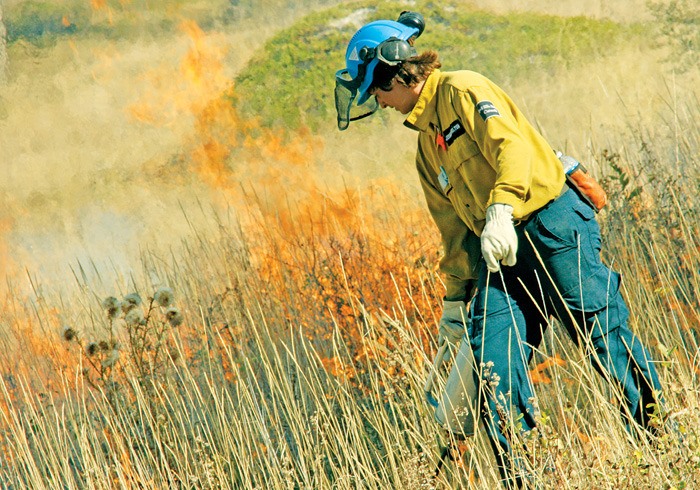Firefighters make their way through the grassland as smoke curls down the side of Redstreak Mountain on the afternoon of September 30.
Carrying drip torches — canisters about the size of a fire extinguisher, which leak flames instead of suppressants — members of the Parks Canada fire crew and the Radium Volunteer Fire Department leave new trails of fire in their wake, which will eventually connect with a blaze started further up the mountain around 1 p.m.
While the burn, a joint project of the province of B.C. and Parks Canada, is scheduled to take place over several days, all the necessary fires are lit on the first day.
A series of containments are set up around the fire site, including a “wet line” of water saturated earth, and a “black line” where all fuels have already been scorched away. Further up the mountain, a helicopter drops water along the edge of the fire, creating another guard.
When the approximately 22 hectare fire burns out near the end of the weekend, another phase of the Redstreak restoration project will be complete.
“This whole prescribed burn in the Redstreak area is to increase wildlife habitat,” explains fire communications officer Julia Millen of Parks Canada.
“Over the last 80 or 100 years or so, we’ve had a lot of fire suppression going on in the parks — and not just in the parks, but in the surrounding areas. Because of that, we’ve had a lot of growth of very closed forests.”
Started in 2005, the Redstreak project is meant to benefit two groups in the Columbia Valley: residents and visitors near the park, and the local population of bighorn sheep.
The sheep, Millen explains, prefer open grassy spaces, which a prescribed burn can create.
“We want to open up some of the area around the slopes of the mountain, so the sheep will have an access route up to their lambing grounds,” she says. “They don’t really like to go through that dense old growth forest.”
Removing old growth also makes it easier to fight wildfires, should they occur in the park.
“What we can do is set fires under controlled conditions, so we have areas on the landscape that act like fire breaks as well,” Millen says.
“So if there is a wildfire that comes into an area, we have more management options.”
While a fire like the one at Redstreak would burn faster and easier in the summer, Parks Canada prefers to conduct its burns in the fall to keep smoke from becoming an issue.
Had the Redstreak burn taken place in July or August, Millen says smoke might have hung over the Radium Hot Springs area for four to six weeks, instead of a couple of days.
